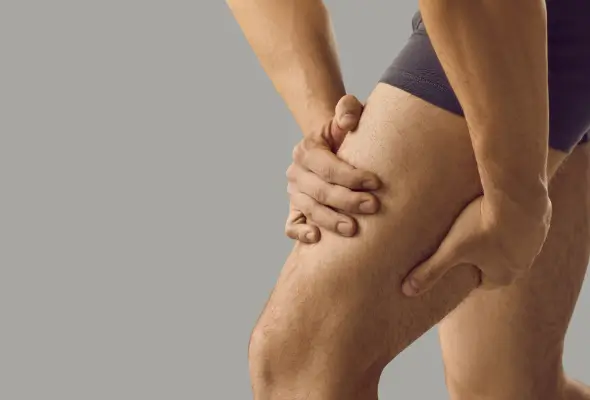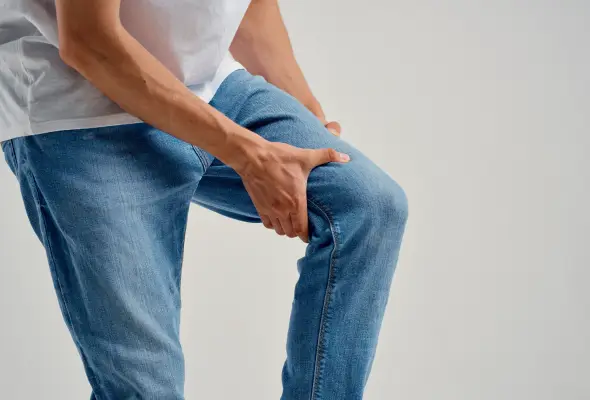-
Doctors
-
Specialities & Treatments
Centre of Excellence
Specialties
Treatments and Procedures
Hospitals & Directions HyderabadCARE Hospitals, Banjara Hills CARE Outpatient Centre, Banjara Hills CARE Hospitals, HITEC City CARE Hospitals, Nampally Gurunanak CARE Hospitals, Musheerabad CARE Hospitals Outpatient Centre, HITEC City CARE Hospitals, Malakpet
HyderabadCARE Hospitals, Banjara Hills CARE Outpatient Centre, Banjara Hills CARE Hospitals, HITEC City CARE Hospitals, Nampally Gurunanak CARE Hospitals, Musheerabad CARE Hospitals Outpatient Centre, HITEC City CARE Hospitals, Malakpet Raipur
Raipur
 Bhubaneswar
Bhubaneswar Visakhapatnam
Visakhapatnam
 Nagpur
Nagpur
 Indore
Indore
 Chh. Sambhajinagar
Chh. SambhajinagarClinics & Medical Centers
Book an AppointmentContact Us
Online Lab Reports
Book an Appointment
Consult Super-Specialist Doctors at CARE Hospitals

Thigh Pain
Symptom, Causes, Diagnosis and Treatment
Thigh Pain
Thigh pain affects many people. It can stem from a myriad of reasons, from minor muscle strains to more severe conditions. Whether it's inner thigh pain, right thigh pain, or discomfort in the upper thigh area, this common issue can significantly impact daily activities and make walking or climbing stairs challenging.
This article aims to shed light on thigh pain, its potential causes, and effective relief methods. We'll explore the different types of thigh pain, including female upper inner thigh pain and thigh pain at night, thigh pain causes and take a look at various treatment options.

What is a Thigh Pain?
Thigh pain refers to discomfort or aching sensations in the upper leg area. It ranges from a mild ache to a sharp, shooting pain or burning sensation, making everyday activities like walking, running, or climbing stairs challenging. This type of pain may occur in various parts of the thigh, including the inner thigh, outer thigh, or upper thigh region.
Thigh pain can stem from numerous causes and can cause symptoms like numbness, tingling, weakness, or swelling. Understanding the nature and cause of thigh pain is crucial for proper diagnosis and treatment, as it can impact a person's mobility and quality of life.
Causes of Thigh Pain
Thigh pain can stem from various sources, such as:
- Trauma: Muscle injuries are common causes, including sprains and strains that affect the ligaments, muscles, or tendons in the thigh. These often result from sudden movements, falls, or intense workouts.
- Overuse: Overuse injuries can also lead to thigh pain, primarily when muscles are worked too hard without proper warm-up.
- Neurological Conditions: Nerve-related issues, such as meralgia paresthetica, can cause shooting pain in the outer thigh.
- Medical Conditions: In some cases, thigh pain may be a symptom of underlying conditions like arthritis or peripheral arterial disease. Blood clots, though rare, can cause unexplained pain in the leg.
- Diabetic Neuropathy: As a complication of diabetes, diabetic neuropathy usually begins in the hands and feet but can also spread to other parts of the body, including the thighs.
- Iliotibial Band Syndrome (ITBS): ITBS occurs when the iliotibial band, which runs along the outside of the thigh from the hip to the outside of the knee, becomes tight and inflamed.
- Bursitis: Ischial bursitis, a condition that pressurizes the cushioning sac between the tendons & bones in your joint, can result in upper thigh pain in the back of your leg.
For those experiencing persistent or severe thigh pain, especially when accompanied by swelling or difficulty walking, it's crucial to consult an expert for proper diagnosis & treatment.

Symptoms of Thigh Pain
Thigh pain can be a mild ache to a sharp, shooting sensation. The discomfort may be accompanied by other symptoms, making everyday activities challenging, such as:
- People often experience burning or tingling sensations in the affected area, which can extend to the upper thigh and hips.
- In some cases, individuals may find it difficult to walk or stretch the thigh muscles.
- Swelling around the painful area is common, particularly following a fall or intense workout.
- The pain may worsen over time, even occurring during rest.
- For those with a sedentary lifestyle, thigh pain might be part of a broader pattern of body aches.
- It's worth noting that pain in nearby areas, such as the hips or knees, could be linked to thigh discomfort.
- In severe cases, symptoms may include unexplained leg pain that persists, along with swelling, redness, or heat along a leg vein.
Diagnosis of Thigh Pain
Diagnosing thigh pain involves a comprehensive approach.
- Physical Assessment: Doctors typically start with a thorough physical examination and take a detailed patient's medical history. They assess the pain pattern, check for swelling, and evaluate muscle strength. The physician may gently press on specific areas or test joint reflexes to gather more information.
- Imaging Techniques: Medical imaging tests like MRI scans, CT scans, or X-rays can help identify issues such as bursae, bone fractures, or tumours.
- Electromyography (EMG): Doctors might order an EMG to check for nerve damage or a joint fluid test to assess joint health for more complex cases.
- Additional Tests:
- Diagnostic nerve block injections to pinpoint nerve-related problems
- Blood tests to reveal markers for conditions like arthritis
- Ultrasounds to detect blood clots
This multi-faceted approach helps doctors determine the underlying cause of thigh pain and develop an effective treatment plan.
Treatment For Thigh Pain
Treating thigh pain involves a combination of home remedies and medical interventions:
- Rest: Rest is crucial, especially within the first 48 hours after experiencing discomfort.
- Heat or Cold Therapy: Applying ice can help reduce swelling and pain, mainly if the issue stems from an injury. Heat therapy may be beneficial for non-injury-related pain, but it's essential to use a barrier to protect the skin.
- Medications: Over-the-counter pain reducers can provide relief. For persistent or severe thigh pain, seeking medical advice is recommended. Additional Therapy: Doctors may suggest physical therapy, prescription medications, or, in rare cases, surgery.
- Physical Activity: Gentle exercises and stretches can aid recovery, but avoiding strenuous activities is essential until the pain subsides. Weight management and maintaining an active lifestyle can also help prevent future thigh pain.
When to See a Doctor
While many cases of thigh pain can be managed at home, certain situations require medical attention. Consult a doctor if:
- If you experience severe or persistent thigh pain that limits your ability to walk or function normally.
- If the pain is accompanied by swelling, redness, or warmth in the affected area.
- Seek immediate medical care if you have sudden severe leg pain, particularly if it's accompanied by breathing problems or an inability to stand.
- Chronic unexplained thigh pain that persists or worsens over time also warrants a visit to a doctor.
- If you suspect deep vein thrombosis (DVT), which can cause calf pain after prolonged sitting, seek urgent medical attention.
- Any injury that causes your thigh to look deformed requires prompt medical evaluation.
Remember, it's always better to err on the side of caution regarding thigh pain and your overall health.
Preventing Measures of Thigh Pain
To reduce the risk of thigh pain, adopting a proactive approach is crucial, such as:
- Warming up and stretching before physical activities can help prevent muscle strains and injuries.
- It's also essential to gradually increase the intensity of exercises, avoiding sudden changes that might lead to overuse injuries.
- Maintaining an optimal body weight can prevent thigh pain, as excess body weight can stress joints and muscles.
- Proper technique when lifting heavy objects or performing athletic movements is essential to avoid injuries.
- Regular exercise and staying active can strengthen muscles and improve overall fitness.
- Wearing appropriate footwear during exercise and staying hydrated can also help prevent thigh pain.
Always listen to your body and avoid pushing beyond your limits. If you experience sudden pain or discomfort, immediately stop performing ongoing activity.
Conclusion
Thigh pain can significantly impact daily life, affecting mobility and overall well-being. Understanding the root cause of thigh pain is crucial to finding effective relief and preventing future occurrences. Proper care and attention are essential for recovery, whether it's a minor muscle strain or a more serious condition.
Maintaining a healthy and active lifestyle is elementary in preventing thigh pain. Medical advice is crucial for persistent or severe pain to ensure appropriate treatment. By staying informed & taking proactive steps, individuals can better manage thigh pain and improve their quality of life.
FAQ's
1. What are the common causes of thigh pain?
Thigh pain can stem from various sources, including muscle strains, trauma, nerve issues, and underlying medical conditions. Common causes include pinched spinal nerves, ischial bursitis, trauma, quadriceps or hamstring tendonitis, and iliotibial band friction syndrome. In some cases, thigh pain may indicate serious conditions {Deep Vein Thrombosis (DVT) or Peripheral Arterial Disease (PAD)}.
2. What are the typical symptoms of thigh pain?
Symptoms of thigh pain can vary depending on the cause. They may include aching, burning, or sharp shooting sensations in the upper leg area. Other symptoms might involve difficulty walking or climbing stairs, numbness, tingling, weakness, or swelling. In some cases, thigh pain may be accompanied by redness, warmth, or tightness near the hip or knee.
3. How do you relieve thigh pain?
To alleviate thigh pain, try resting the affected area, applying ice or heat, & taking medications as prescribed by your doctor. Gentle stretching and strengthening exercises for the pelvis, hip, and core can also help. For persistent or severe pain, consult a doctor who may recommend physical therapy, prescription medications, or, in some cases, surgery.
4. Can thigh pain be serious?
While most cases of thigh pain are not serious, some instances can indicate severe conditions. Deep vein thrombosis, for example, can be life-threatening if left untreated. If you experience sudden severe leg pain, especially when accompanied by swelling, redness, or difficulty breathing, seek immediate medical attention.
5. Is walking good for thigh muscle pain?
Walking can benefit some types of thigh pain, especially those related to muscle strains or overuse injuries. It helps improve blood flow, strengthens muscles, and maintains joint flexibility. However, if walking exacerbates your pain or you're unsure about the cause of your thigh pain, consult an expert before starting any new exercise routine.

Still Have a Question?



